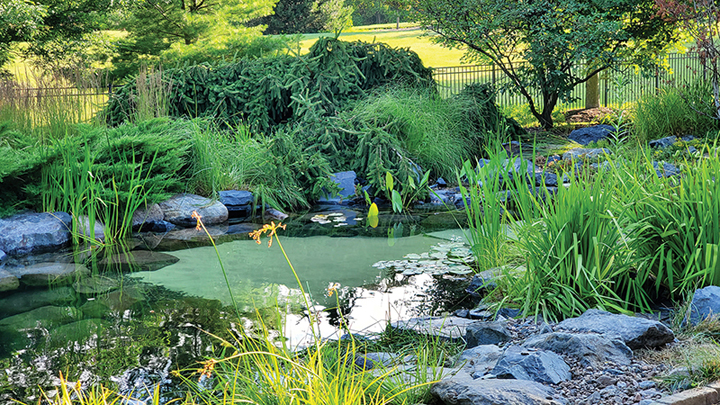
I was taught early on as a pond professional not to put sand on the bottom of a pond, and I’ve always just accepted it as best practice in the pond-construction industry.
After all, I have heard quite a few objections over the years. “Sand can’t be brushed or vacuumed effectively, so it will be nearly impossible to keep it clean. That won’t make your clients happy!” “Installing sand on the bottom of a pond or natural pool might create an environment where harmful microbes could dwell, and that may put your clients and their expensive koi fish at risk of contracting a waterborne illness!” “Any disturbance in the sand, whether it be a fish foraging for food, a strong current of water or a human footprint, would toss so much sand and debris into the water column that the pond would become cloudy. It would be very difficult, if not impossible to keep the water clear!” I could go on and on.
So, whenever I heard a client say, “I want my pond to look like a tropical oasis — a soft, sandy beach that we can wade and lounge in,” I often found myself repeating all these objections and attempting to compromise. After all, as a professional designer and builder, I have a responsibility to find middle ground between my client’s design goals and best practices for construction, right?
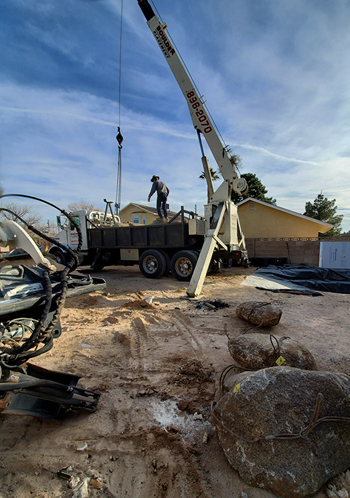
For my company, Reflections Water Gardens, the client’s creativity is an essential piece of the design process, so we never want to give them an outright “no.” Our culture is to work closely with our clients so that we understand and embrace all their design goals, translating those concepts into their own perfect oasis of tranquility.
Figuring out how to realize the client’s vision is part of the fun of being a designer, and it’s that maxim that fuels my creativity as an artist. With this motivation always at the back of my mind, I told myself that the next time a client asked me about creating a pond with a sandy, tropical look, I would not see that as a problem, but as an opportunity to try something new and different, something bold that others had told me not to do, and something beautiful that my clients could proudly claim as their own perfect oasis.
Before long, sand-bottom ponds became the shiny thing in my peripheral vision that prevented me from thinking about anything else. I was far too excited to wait around for a client to ask me to build one, so while hunkering down at our home in Illinois during another cold Midwestern winter, I decided to be proactive and set out in search of others who were designing and building these tropical-looking water features. After many hours of internet research and browsing through Facebook groups and Instagram stories, I came across a Brazilian company called Genesis Ecosystems that offered ornamental ponds and lagoon-style, natural swimming pools with remarkably clean sandy bottoms, lush tropical landscaping and crystal-clear water. I kept this in mind for any future clients who might ask me to create an oasis in their backyard.
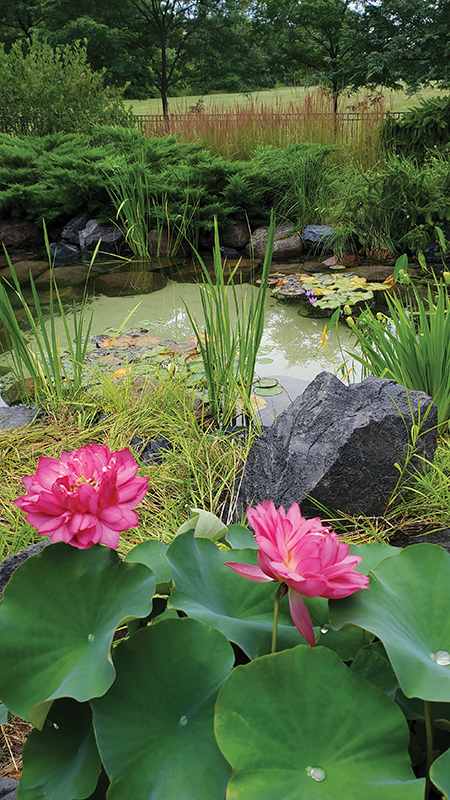
I contacted my friend and fellow pond builder Hector Mardueño at Stonewall Creek in Las Vegas and, with an enthusiastic tone in my voice, told him about the sand-bottom ponds I had seen by Genesis Ecosystems. Hector had also recently seen photos of sand-bottom ponds popping up on the internet, and it was clear that we were both very intrigued by the concept. We kept in touch throughout the winter and talked about how we thought they could be built. Was there some nuance in the way these sand-bottom ponds were being constructed in Brazil that simply had not yet made its way to the United States? We were compelled to learn more.
I started following the principal of Genesis Ecosystems, Ricardo Caporossi Júnior, on social media and became further inspired by his photos of sand-bottom ponds and natural-pool installations. One day in late summer 2019, he posted an Instagram story from a Bass Pro Shop in Chicago, so I reached out to him and invited him to my home in West Dundee, Illinois, to see the natural pool I had built nearly 10 years prior. We enjoyed a meal together while talking about different methods for pond construction and the challenges we’ve faced in the creation of natural-looking water features.
Ricardo revealed to me that the success of his company’s sand-bottom ponds was based on a combination of biology, material selection and modern technology. It was at that point that I knew these techniques were transferrable to the United States. There was no “secret sauce” — just a carefully crafted recipe that yielded the kind of high-quality results I had been searching for.
I’m no stranger to enhancing freshwater ecosystems with modern technology in order replicate the conditions found in natural bodies of water. But the tropical look was one that still eluded me. Inspired by my conversation with Ricardo, I decided it was time to do a little experimenting of my own.
To the Desert!
I called Hector in Las Vegas and told him that I wanted to attempt to build a sand-bottom pond. Hector had been toying with the idea of putting in a pond at his house, and since the Nevada desert seemed like a perfect testing site for our new tropical-oasis concept, he volunteered his backyard as our laboratory.
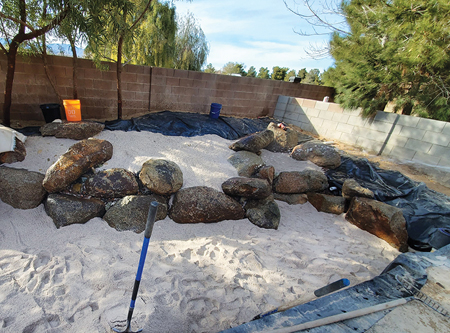
We were both excited by the opportunity. We agreed that I would provide the labor to build the pond and the aesthetic design for the surrounding landscape, and he would provide all the equipment and materials that we needed for construction. In February 2020, I flew down to Las Vegas along with two of my best crew to join forces with Hector and start building the pond. When we arrived, the excavation had already begun. As soon as I saw the footprint of the pond, I knew that we were going to need to bring in some large boulders to make it look as natural and as tropical as possible. After fine-tuning the edges and shaping the shelves where the rocks would be placed, we went hunting for the perfect boulders, landscape plants and other elements that would adorn our oasis.
I knew from my talks with Ricardo that the quality of sand was a very important piece of the puzzle. Regular beach sand simply wouldn’t allow the system to work properly. We had to use a special kind of silica sand, and it would have to be very clean and dense enough to fall out of suspension quickly — not so fine that it would prevent water from flowing through it, but not so coarse that it would harbor sediment and detritus.
We went to multiple stone yards and landscape suppliers in the surrounding area trying to find just the right stuff, testing a small sample of each type of sand in a bottle of water to make sure it had the properties we were looking for. We found a type that came really close to matching Ricardo’s description, and after doing our calculations, we ordered enough of it to cover the bottom of the pond and the shelves.
Filtration
With the fabric underlayment and liner already installed, it was time to truck in more than 33 tons of boulders to create our rocky, tropical oasis. Access to the site was good, and we were able to crane our boulders right off the back of the truck. After getting them all lined up so we could see what we had to work with, I put on my artist’s cap and got to work placing boulders. Hector put on his engineer’s cap and figured out a way to distribute water evenly throughout the sand.
Another important lesson I learned from Ricardo is that sand-bottom ponds should flow water upward through the sand in order to help keep it clean and prevent dead spots where bacteria could thrive. The concept of an under-gravel filter was nothing new to us, but to do it with sand seemed counterintuitive and presented a new challenge. Hector developed a solution that incorporated multiple discharge points under the sand to flow water evenly throughout the entire pond bottom. We also learned that fish would play an important role in this new, sand-bottom pond ecosystem. If we got fish that were large enough, they would constantly graze on any algae that might be growing on the pond bottom, and the sweeping motion of their tails would help toss debris into suspension and ultimately into the skimmers. Along with the continuous flow of water upward through the sand, this combination of biology and technology would effectively keep the sand looking clean and free of obstructions.
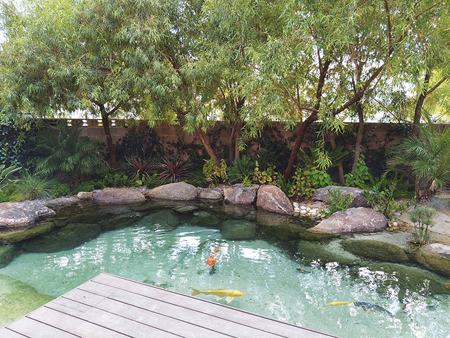
I advised Hector on the sizing of the plumbing and filtration systems. His crew finished the installation of the skimmers, pumps, plumbing, ozone system and filter while we finished the boulder placement and covered the bottom of the pond with sand. Although the sand came from the yard labeled as “washed,” we knew that it would need to be flushed multiple times to eliminate any lingering fine particles. We filled the pond slowly with water, stirred up the sand, pumped it down, filled it up again and repeated that process several times until the water ran clear.
Once the sand was thoroughly washed, we filled up the pond one last time, and all the underwater stonework was revealed. I was fascinated by the way the sand had found its way into the smallest of gaps between boulders, creating a spectacular visual contrast between the dark-colored walls and the light-colored bottom of the pond. It reminded me of a pool at the bottom of a tropical waterfall. As an artist and designer, it was truly a delight to see how perfectly all the project elements were blending together.
The entire process from excavation to landscaping took us roughly two weeks to complete.
Interest Ignites!
After designing and installing the native landscaping behind the pond, it was time to say goodbye to Hector and leave him to do the initial startup of the pond. We checked in with each other from time to time over the next few months, and Hector reported that everything was running well, and the pond was looking great. He told me that he had recently completed another sand-bottom display pond at his retail shop using similar techniques, and the concept was receiving a lot of praise and attention. It wasn’t long before Hector told me that he had multiple sand-bottom ponds on the drawing board for new clients.
Later that summer I returned to Las Vegas to see our oasis and take some photos, and I was impressed by how well it was performing. The fish were healthy and happy. The water was clear and free of algae. Even the sand was clean except for a few leaves that had recently fallen from a tree overhanging the edge of the pond. Hector did note that there were some growing pains and lessons learned in the first few months of operation. (At one point when the ozone system went down, the water went a bit green.) But overall, the installation was a success and a beautiful showcase of our first tropical oasis pond with a sandy bottom.
Bringing it Home
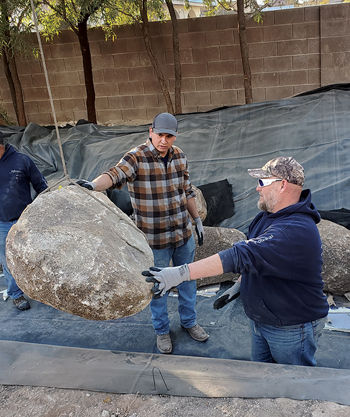
After seeing first-hand how well received our oasis was, I was inspired to retrofit my own natural pool with a sand-bottom pond. My pool has evolved many times over the years as I’ve learned new techniques for filtering water, setting stones and constructing wetland areas. Some of these methods I’ve developed on my own as a result of making mistakes or recognizing ways to build things more efficiently, but it was my collaboration with Hector on our first oasis that gave me the confidence, know-how and motivation to attempt one on my own.
It couldn’t have been easier. My local crew and I completed it in less than a day. I found a local source for sand that passed my “shake-it-up-in-a-water-bottle test” with flying colors. We repurposed an old 2-inch return line to feed water to the shallow lounging area of the pool, which was to become a new sandy beach.
This shallow lounging area has become a favorite spot for my German Shepherds. They love to sun themselves on the rocks, splash about in the water, chase dragonflies through the aquatic planting beds and, frankly, make a mess of everything. I knew one of the challenges I’d face after installing a sand-bottom in the dogs’ favorite play area would be figuring out how to prevent the sand from migrating from the shallow lounging area down to the gravel-covered suction grid at the deep end of the pool. I didn’t want the sand to erode down the slope of the pool or clog up my under-gravel filter, so we took extra care to use a graduated selection of boulders, cobbles and pebbles to seal up any voids. This also created a natural transition from the boulders to the sand.
It turned out great, and I couldn’t be happier with the way it has performed. The water in the pool is as clear as it’s ever been. I have an evenly distributed flow of water through the beach with no visible channeling, and the sand has stayed sparkling clean and white throughout the entire season.
I’m thankful for the inspiration and insight provided by Ricardo at Genesis Ecosystems and the lessons learned through collaborating with Hector through the design and construction of our first sand-bottom pond. My company now proudly offers oasis-inspired, sand-bottom ponds and natural pools to our clients across the country.
In the wake of the pandemic, when protecting the health and safety of our families and communities has become so vitally important, when congregating at beaches and other outdoor public spaces has become increasingly difficult, when travel options to exotic destinations have become so narrowly limited, and when more people than ever are staying home, taking a tropical vacation in your own backyard just got a little bit more attainable.



What do you think it would be the best size of sand? pool filter sand?1-.8 mm?
I am working on a natural pond/swimming pool that will use the local tide for all pumping and draining needs. This article has been an absolute godsend, as I absolutely want sand on the bottom of this pond. Thank you for sharing what you have learned!!
Hi!
Can you tell the exact type of sand that works best for this project? Thank you for the article!
It all depends on your goals. I will use sand that is washed and free of fines. Sand that glass could be made out of. Swimming pool filter sand works well
Can you still have water lilies in a sand bottom pond?
Hello Lucas good question. Yes you can have water lilies in a sand bottom pond. The tuber could be planted directly in the sand, but they’ll do best if left in the pots. If you look at the photo halfway through the article (the one with the two pink lotus flowers in the foreground) you’ll see we have lots of water lilies in the pond. We kept them in the pots and covered them with a thin layer of sand for a seamless look.
A very helpful post about to build a sustainable sand bottom pond. Thank you for sharing, please keep sharing more.
I have to put some sandbags in the bottom of my fish pond. Any ideas on what is the best type of sand to use given that it will be contained within the bags, as I want the fish to be safe.
Thanking you in anticipation.
Any type of clean sand should work. The issue would be the sand inside the bag not getting washed and becoming anerobic at the bottom of your pond
Do you put anything between the liner and the sand? I was told to put a foot of dirt on top of the liner before putting in the sand.
If you want your pond to look like the photos in the article then just use sand. No dirt.
Is ozone a integral part of using sand or could a uv do the job?
My personal pool has UV and a nano-oxygen system but no ozone.
How do the returns work under the sand? Is it lots of pipe with holes? Struggling to imagine what this looks like.
Multiple small jet returns or a grid of pvc with holes drilled. Either way the water will channel through the sand and take the path of least resistance
How many inches of sand over the grid do you recommend for good flow and protection from walking on them in shallow end ?
Thank you for the info, I’m sooo excited to do this !
At least 6 inches. Remember that the water will channel and find the path of leas resistance. Also the sand will move around easily since there’s no fines in it to lock it together
How is it doing after 2 years, still clean sand? I wondering if ozone free sand bottom is viable long term.
Doing well. I actually just started my filtration system now that winter is over.
Hi, wonderful article. What diameter piping did you use under the sand, and how close together were the pipes? How close are the holes to one another? Also, do you feed under the sand with another pump, or the same pump that draws the water through the filter gravel?
It was built like a typical suction grid but in reverse using the filtration pump. Only one pump for this project.
Thank you very much from Mallorca, an island in the Mediterranean Sea, in Spain!!! Knowledge has no distance. My name is Vanessa and I am going to build myself and for the first time a pond with a sandy bottom, which I intend to use for swimming as well. I know it’s a major challenge, I don’t want to harm the fish, but I think I’ve collected all the information correctly. My main problem is going to be bringing giant rocks with a wheelbarrow!! LOL
And if you want an apprentice in the distance, your advice is welcome! Who knows if I start my own business in Mallorca!
Thank you from Italy. Great reading. Could you tell more about the nano-oxygen system. I have been doing some reading but they all seems to be very expensive and not available in EU
Hi Peter
The nano systems can get expensive. Especially if you cannot find one in the EU. They work very well by keeping the bubbles suspended in water until used up. We runout systems to stay around 350 orp otherwise the biological process would be oxidized and start down the path of sterilization.
What Nano system do you use and how to calculate the Nano system required for a pond?
It’s our own system we developed. If you would like us to design a system for you contact us on our website ReflectionsWaterGardens.com
Love this article!! We live in Yuma AZ, land of blowing sand. Would natural blowing sand be detrimental to this type of pond? We want a chemical free pond for beauty and to cool off in. Will it work here? Any experienced contractors in our area to help out?
Thanks – Dave
I’m looking to do this in Australia.
I’m struggling to picture how the drainage works.
So you dig a hole, lay out the liner/underlay, install rows of pipework with holes in and the bury them in sand, but how does the sand not get sucked straight into the holes?
Thanks for your time.
Return water under the sand instead of suction
What ozone system did you go for and do you have any photos/videos of how you installed it?
Hey Ryan, I combine multiple components to make our systems work the way they do. I can help you size a system if you want. Fill out the form on my website and I’ll contact you.
http://www.ReflectionsWaterGardens.com